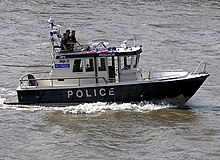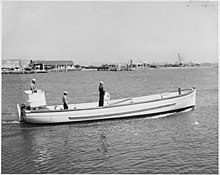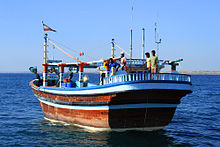Launch (boat): Difference between revisions
→References: notelist |
m →History: missing word |
||
| Line 24: | Line 24: | ||
The launches issued to naval ships varied in size depending on the size of the ship they equipped. An 1815 schedule of ship's boats showed the range of 15 different lengths for launches from 34 feet (for a ship of 100 guns) down to 16 feet for a 200 ton sloop. As steam power became common in the navy, the need to transport drinking water (which could be distilled in the engine room) and transport anchors and cables to move a sailing ship both disappeared. By the last quart of the 19th century, launches were only issued in one length, 42 feet.{{r|May 1999|pp=62, 71}} |
The launches issued to naval ships varied in size depending on the size of the ship they equipped. An 1815 schedule of ship's boats showed the range of 15 different lengths for launches from 34 feet (for a ship of 100 guns) down to 16 feet for a 200 ton sloop. As steam power became common in the navy, the need to transport drinking water (which could be distilled in the engine room) and transport anchors and cables to move a sailing ship both disappeared. By the last quart of the 19th century, launches were only issued in one length, 42 feet.{{r|May 1999|pp=62, 71}} |
||
Launches had double-banked oars{{efn|A double-banked boat has two oarsmen seated on each thwart, each operating their own oar on their side of the boat. This contrasts with a single-banked boat, with just one oarsman on each thwart operating a single oar, with side on which the oars are worked alternating along the length of the boat.}} The usual sailing rig for much of the 19th century was a two-masted ketch rig. A schooner rig was in use from 1878 and the de Horsey sloop rig was adopted from 1884.{{r|May 1999|pp=91-97}} |
Launches had double-banked oars{{efn|A double-banked boat has two oarsmen seated on each thwart, each operating their own oar on their side of the boat. This contrasts with a single-banked boat, with just one oarsman on each thwart operating a single oar, with the side on which the oars are worked alternating along the length of the boat.}} The usual sailing rig for much of the 19th century was a two-masted ketch rig. A schooner rig was in use from 1878 and the de Horsey sloop rig was adopted from 1884.{{r|May 1999|pp=91-97}} |
||
The word "launch" comes from the [[Spanish language|Spanish]] ''lancha'' ("barge") and [[Portuguese language|Portuguese]], from [[Malay language|Malay]] ''[[Lancaran (ship)|lancaran]]'' ("swift boat"), which in turn derived from ''lancar'' ("velocity without effort").<ref>{{cite book |title=Collins English Dictionary |edition=Second |publisher=Collins |location=London, Glasgow |year=1986 |page=868 |isbn=0 00 433135-4}}</ref> |
The word "launch" comes from the [[Spanish language|Spanish]] ''lancha'' ("barge") and [[Portuguese language|Portuguese]], from [[Malay language|Malay]] ''[[Lancaran (ship)|lancaran]]'' ("swift boat"), which in turn derived from ''lancar'' ("velocity without effort").<ref>{{cite book |title=Collins English Dictionary |edition=Second |publisher=Collins |location=London, Glasgow |year=1986 |page=868 |isbn=0 00 433135-4}}</ref> |
||
Revision as of 14:51, 9 January 2022
The examples and perspective in this article may not represent a worldwide view of the subject. (January 2022) |


Launch is a name given to several different types of boat. The wide range of usage of the name extends from utilitarian craft through to pleasure boats built to a very high standard.
In naval use, the launch was introduced as a ship's boat towards the end of the 17th century. On each warship, the launch was usually the largest boat out of those carried aboard. It could be propelled by oar or sail, with this type remaining in service into the 20th century. Steam launches were introduced on a trial basis in 1867, but as steam-powered ship's boats became more common, the majority were the steam pinnaces.
Other military examples were the various motor launches used particularly in the 20th century, employed for harbour defence, anti-submarine patrols, escorting coastal convoys, minesweeping and recovering aircrew from crashed aircraft. Generally, these were decked boats, some of which were capable of fast speeds.
A powered boat operated by a regulatory or official organisation may be termed a launch – such as the police launch or a harbour-master's launch. The size range and capabilities vary according to the precise role.
In private use, a launch is invariably a powered boat, using a steam, electric, petrol or diesel engine. Some are built to a very high standard of finish, with large amounts of varnished hardwood and polished fittings.[1] Various local historic types are kept in use by enthusiasts and museums.


History
The launch steadily replaced the long-boat in the Royal Navy over the latter half of the 18th century. Both were usually the biggest boat carried by a warship or a merchant vessel in the age of sail. The transition from longboat to launch was influenced by the East India Company successfully experimenting with this change.[2]: 41–43
Launches were preferred as having greater carrying capacity, though they could be considered less seaworthy. An important role was the carrying of drinking water. For example, a 33 foot launch of 1804 could carry 14 large "leaguers" (barrels containing 150 imperial gallons (680 L) each), making a load of just over nine and half tonnes of water. A warship's launch would also be fitted with a windlass that allowed a ship's anchor to be carried or to be weighed (raised). A ship's boat would often be used to kedge a ship out of a harbour or away from a hazard such as a lee shore before steam tugs were available to move sailing vessels.[2]: 41–43
The launches issued to naval ships varied in size depending on the size of the ship they equipped. An 1815 schedule of ship's boats showed the range of 15 different lengths for launches from 34 feet (for a ship of 100 guns) down to 16 feet for a 200 ton sloop. As steam power became common in the navy, the need to transport drinking water (which could be distilled in the engine room) and transport anchors and cables to move a sailing ship both disappeared. By the last quart of the 19th century, launches were only issued in one length, 42 feet.[2]: 62, 71
Launches had double-banked oars[a] The usual sailing rig for much of the 19th century was a two-masted ketch rig. A schooner rig was in use from 1878 and the de Horsey sloop rig was adopted from 1884.[2]: 91–97
The word "launch" comes from the Spanish lancha ("barge") and Portuguese, from Malay lancaran ("swift boat"), which in turn derived from lancar ("velocity without effort").[3]
In the age of sail, a ship carried a variety of boats of different sizes and uses. In addition to the launch, examples include the jolly boat, captain's gig, pinnace, cutter, longboat, and whaleboat. Distinctions among the smaller vessels were not always clear, both in design and purpose.[4] In the age of motorized vessels, including the Motor Launch, these distinctions have largely disappeared, but the historic terms continue in use.
During the Demak Sultanate attack on Portuguese Malacca of 1513, lancaran were used as armed troop transports for landing alongside penjajap and kelulus, as the Javanese junks were too large to approach shore.[5]
In the 18th century, a launch was used to set the large anchors on a ship. The launch of that era had a square transom and was about 24 feet long. In 1788 Captain Bligh was set adrift in Bounty’s launch.
Civilian use in the UK
On the River Thames the term "launch" is used to mean any motorised pleasure boat. The usage arises from the legislation[6] governing the management of the Thames and laying down the categories of boats and the tolls for which they were liable.
Military launches in the UK
Motor Launch was the designation for a type of vessel used in World War II by the Royal Navy and some other navies[citation needed] for inshore work defending the coast from submarines. They were typically 60-to-115-foot or 18-to-35-metre long and carried relatively light armament – a few depth charges, a gun and a few machine guns.
Sports
In competitive rowing the term "launch" is used to refer to any motorized boat used by the coach to follow practicing boats during workouts.[citation needed]
See also
- RAF rescue launch
- Cabin cruiser
- Slipper launch
- Naphtha launch – Small motorboat used in the late-19th-century United States
- Picket boat, a naval launch
Notes
- ^ A double-banked boat has two oarsmen seated on each thwart, each operating their own oar on their side of the boat. This contrasts with a single-banked boat, with just one oarsman on each thwart operating a single oar, with the side on which the oars are worked alternating along the length of the boat.
References
- ^ Owner, Practical Boat (11 November 2014). "Glossary of Nautical Terms: L". Practical Boat Owner.
- ^ a b c d May, W E; Stephens, Simon (1999). The Boats of Men of War (2003 publ Caxton Editions ed.). London: Chatham Publishing. ISBN 1-84067-4318.
- ^ Collins English Dictionary (Second ed.). London, Glasgow: Collins. 1986. p. 868. ISBN 0 00 433135-4.
- ^ Folkard, Henry Coleman (1863). The Sailing Boat: a Treatise On English And Foreign Boats, Descriptive of the Various Forms of Boats And Sails of Every Nation; With Practical Directions for Sailing, Management. London: Longman, Green, and Roberts.
- ^ Winstedt, Sir Richard (1962). A History of Malaya. Marican.
- ^ Thames Conservancy Act 1932
